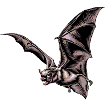Museum, University of Nebraska State

University of Nebraska State Museum: Mammalogy Papers
Document Type
Article
Date of this Version
12-27-1996
Citation
Mammalian Species (December 27, 1996) No. 534: 1-8.
Online archive: http://www.science.smith.edu/departments/Biology/VHAYSSEN/msi/
Abstract
Eumops perotis is the largest bat in the United States. The greater mastiff bat resembles other North American free-tailed bats, but is distinguished from other molossids by its large size and lack of long guard hairs on the rump (Barbour and Davis, 1969). E. perotis has the thinnest dentary of any Eumops (Freeman, 1981a).In the United States, E. perotis can be separated from E. underwoodi by its larger size (forearm is 73-83 mm in E. perotis and 65-77 mm in E. underwoodi), darker color, and lack of long guard hairs on the rump. The ears are longer (36-47 mm in E. perotis and 28-32 mm in E. underwoodi), they extend beyond the nose when laid forward, and they are joined at the midline. In E. perotis, the tragus is large, broad, and square, the greatest length of the skull usually is >30 mm rather than less, the basisphenoid pits are large, deep, and not oval shaped, and the third transverse commissure of the M3 hardly is discernible (Barbour and Davis, 1969; Hoffmeister, 1986). Compared with E. perotis, the skull of E. underwoodi (Fig. 2) is shorter, wider, and less robust, and the interorbital region is distinctly hourglass-shaped rather than nearly cylindrical as in E. perotis (Benson, 1947). Compared with E. perotis, E. dabbenei has shorter ears, smaller pointed tragus, more massive skull, and the basisphenoid pits are shallower and less developed (Eger, 1977).


Comments
Copyright © 1996, American Society of Mammalogists. Used by permission.